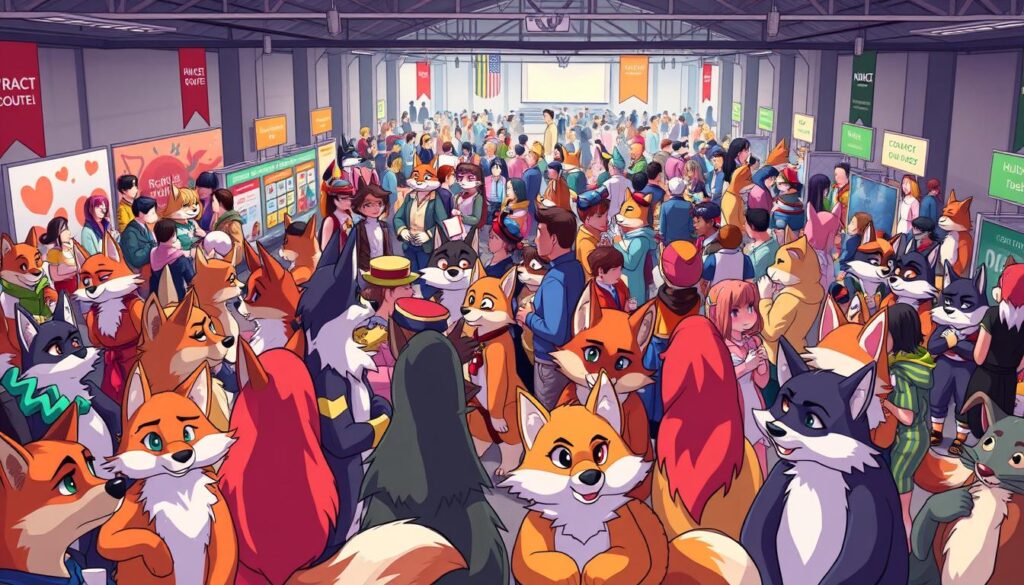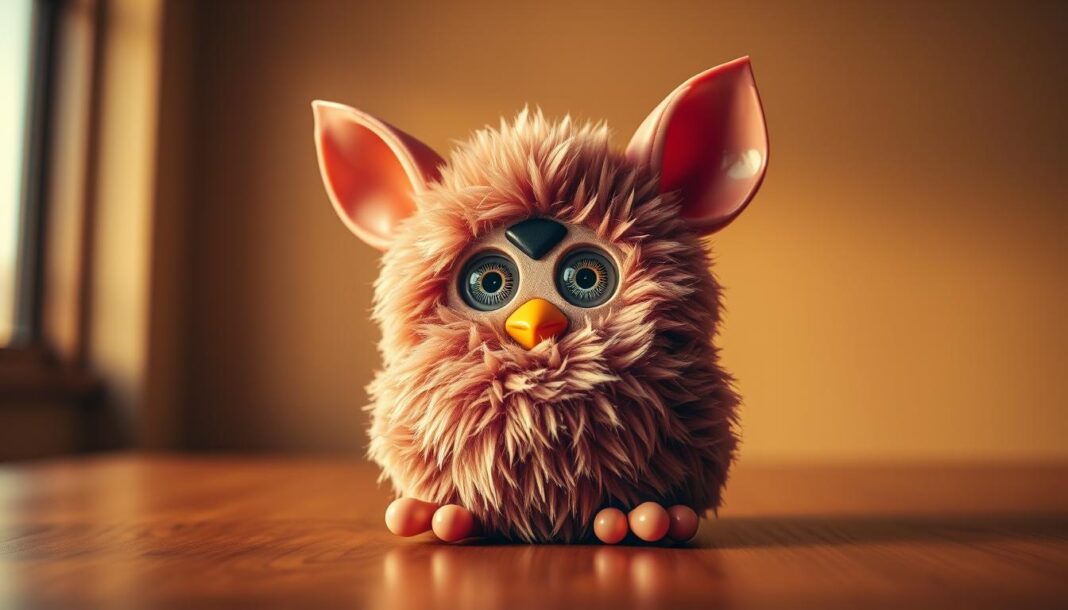Estimating the size of the furry community is tricky. The group thrives online and at events, but many members prefer anonymity. This makes it hard to pin down exact figures.
Research from FurScience suggests there could be hundreds of thousands involved worldwide. Online hubs like Fur Affinity host tens of thousands of active users. The furry fandom also gathers at large conventions, with Anthrocon growing from 500 to over 9,000 attendees since the 1990s.
Without official records, precise data remains scarce. The decentralized nature of the community adds to the challenge. For more insights, check our detailed statistics on furry demographics.
What Is the Furry Fandom?
What began as a niche interest has grown into a vibrant global phenomenon. The furry fandom centers on anthropomorphic characters—animals with human traits. Members often create fursonas, personalized avatars reflecting their identity.
Defining Furries and Fursonas
A furry is someone who enjoys anthropomorphic art, stories, or roleplay. Fursonas range from wolves to dragons, each with unique designs. These personas let fans explore creativity and belonging.

Origins and Evolution of the Community
The fandom traces its roots to 1980s sci-fi conventions and underground comics. Early adopters connected via Usenet groups, laying the groundwork. The internet exploded its growth—platforms like FurNation and Yerf became hubs in the 1990s.
Today, over 300 annual conventions unite the community. A 2023 FurScience survey found 80%+ identify as LGBTQ+, showcasing its inclusivity. From niche to mainstream, the fandom thrives worldwide.
How Many People Are Furries? Global Estimates
Measuring the furry community’s size presents unique challenges due to its diverse and decentralized nature. Unlike formal organizations, the fandom thrives online and at events, making headcounts unreliable.

Challenges in Counting the Furry Population
Several factors complicate research into the fandom’s size:
- Anonymity: Many members use pseudonyms or fursonas, avoiding public identification.
- Methodology gaps: Online polls may miss offline participants, while convention attendance fluctuates yearly.
- Global spread: The community spans the world, with varying participation levels per region.
Key Surveys and Research Findings
FurScience’s 12-year longitudinal study, covering 15,000+ participants, offers the most comprehensive estimates. Key insights include:
- 2023 projections: 1–3 million furries globally.
- Pew Research found 5% of U.S. adults personally know someone in the fandom.
- Convention headcounts (e.g., Anthrocon’s 9,000+ attendees) underrepresent casual fans.
While exact numbers are debated, the fandom’s cultural impact is undeniable—and growing.
The Role of Furry Conventions in Tracking Growth
Annual gatherings offer the clearest snapshot of the furry community’s growth. These events blend creativity, charity, and safety protocols, revealing trends over time.
Major Conventions and Attendance Trends
Anthrocon dominates as the largest convention, drawing 9,000+ attendees yearly. Midwest FurFest follows closely, with a record 13,000 participants in 2022. Both events reflect an 18% annual growth rate.
Smaller gatherings like Eurofurence (12% growth) and FurDU (9%) show the fandom’s global spread. For deeper insights, explore furry demographics stats.
Anthrocon and Midwest FurFest Case Studies
Anthrocon’s charity arm has donated $700,000+ to animal shelters since 1997. Its auctions fund local causes, blending fandom with philanthropy.
Midwest FurFest overhauled safety after a 2014 chlorine attack. Today, it allocates $250,000 yearly for security. The community also enforces strict anti-alt-furry policies, fostering inclusivity since 2017.
Regional Distribution of Furries Worldwide
From North America to Asia, furry communities thrive in unique cultural contexts. While conventions and online activity highlight hotspots, regional differences shape participation and visibility.
North America’s Dominance in the Fandom
The U.S. and Canada host the largest furry gatherings. Anthrocon and Midwest FurFest attract 65% of surveyed attendees, per FurScience. These events blend art shows, charity auctions, and inclusive policies.
Europe’s Thriving Furry Communities
Berlin’s Eurofurence draws 3,500+ attendees yearly. Smaller events in the UK and Netherlands emphasize niche interests, like fursuit design. Europe’s furry scene balances tradition with innovation.
Emerging Scenes in Asia and Beyond
Asia’s growth is notable. Japan’s Kemono Friends convention doubled attendance to 8,000 in 2023. Meanwhile, China’s underground networks flourish on QQ and WeChat. Cultural barriers persist—78% of Asian furries hide their involvement from families.
| Region | Largest Event | Attendance (2023) |
|---|---|---|
| North America | Anthrocon | 9,000+ |
| Europe | Eurofurence | 3,500+ |
| Asia | Kemono Friends | 8,000 |
Singapore’s Fur-Eh! leads Southeast Asia’s furry scene. For deeper insights, explore global furry demographics.
Demographics: Who Makes Up the Furry Community?
The furry fandom stands out for its diverse and welcoming demographics. Unlike many subcultures, it thrives on inclusivity, attracting members across age groups, genders, and neurotypes.
Age, Gender, and Identity Trends
Most furries are young adults, with 65% aged 18–35. Gender diversity is striking—over 80% identify as LGBTQ+, and nonbinary participation is triple the general population’s rate.
Fursonas often reflect personal journeys. A 2023 FurScience study found 40% use their avatar to explore gender expression. This creative freedom fosters a strong sense of belonging.
Neurodiversity and Inclusivity
Neurodivergence is prevalent: 47% report autism spectrum diagnoses versus 2.8% nationally. The community adapts with sensory-friendly fursuits—think weighted paws and muted colors.
Groups like Autism Furs on Telegram offer support. Animal behavior expert Temple Grandin praises the fandom as a haven for ASD individuals, citing its structured yet creative life.
From tailored events to online safe spaces, the furry world champions neurodiversity. Its ethos? Celebrate differences, one fursona at a time.
The Fandom’s Online Presence and Metrics
Digital spaces fuel the furry fandom’s global reach. From art-sharing hubs to niche forums, the community thrives in virtual environments. These platforms offer both visibility and anonymity, catering to diverse participation levels.
Social Media and Forum Activity
Fur Affinity, the largest furry art platform, hosts 12M+ users. Its 2023 overhaul introduced stricter CSAM filters, balancing creativity with safety. Smaller sites like SoFurry and Inkbunny cater to specific niches, from SFW comics to adult content.
Activity spans a wide range of platforms. Reddit’s r/furry (400K+ members) enforces anti-harassment policies, while 4chan’s /furs/ board allows edgier discussions. This contrast highlights the fandom’s adaptability to different online cultures.
Fur Affinity and Reddit Communities
Monetization drives engagement too. FurBuy, a $15/month commissions platform, lets artists profit from their work. Patreon and Ko-fi supplement incomes, with top creators earning $5K+ monthly.
From memes to masterpieces, the fandom’s digital footprint keeps growing. Virtual spaces aren’t just conveniences—they’re the heartbeat of modern furry culture.
Cultural Impact of the Furry Fandom
Beyond fursuits and conventions, the furry fandom shapes culture in unexpected ways. Its members drive creativity and philanthropy, leaving a mark on art, media, and social causes.
Art, Literature, and Media Contributions
The community thrives on original content. Platforms like Fur Affinity host 1.2M+ artworks annually, from comics to animations. Independent publishers like Sofawolf Press release award-winning anthologies.
Mainstream media increasingly taps into furry aesthetics. Netflix’s Beastars and Disney’s Zootopia reflect anthropomorphic storytelling’s appeal. These works owe part of their success to furry artists’ pioneering styles.
Charity Work and Fundraising
Furries raised $3.8M for charities in 2022, per CharityPaws. Their efforts blend creativity with compassion:
- Furry Aid: Funded disaster relief in 12 countries, including wildfire recovery kits.
- Fursuit for a Cure: Raised $500K+ for cancer research via auctioned costumes.
- PETA debates: The fandom advocates for ethical faux fur, despite clashes over “animal persona” ethics.
| Initiative | Funds Raised (2022) | Cause |
|---|---|---|
| Anthrocon Charity Auction | $320,000 | Local animal shelters |
| Midwest FurFest Giving | $275,000 | LGBTQ+ youth programs |
| Eurofurence Paws Forward | $190,000 | Disability access tech |
From galleries to global aid, the fandom proves its cultural weight. Its blend of artistry and altruism redefines what a community can achieve.
Misconceptions and Stereotypes Debunked
From bizarre hoaxes to harmful stereotypes, furries battle misinformation daily. The fandom’s creativity and inclusivity often get lost in sensationalized narratives. Let’s separate fact from fiction.
The “Litter Box” Hoax and Media Fallout
In 2022, NBC traced the viral litter box hoax to school safety buckets, not actual requests. Far-right forums like 4chan and 8kun amplified the false claim, alleging schools provided litter boxes for students identifying as animals.
Politicians like Marjorie Taylor Greene and Lauren Boebert weaponized the myth. Their tweets sparked nationwide panic, despite zero evidence. The fallout was real—33% of teen furries reported increased bullying, per FurScience.
| Timeline | Key Event | Impact |
|---|---|---|
| 2021 | Hoax originates on 8kun | Meme spreads via alt-right channels |
| 2022 | MTG tweets false claim | National media coverage escalates |
| 2023 | NBC debunks story | School districts issue denials |
Separating Fact from Fiction
The media often conflates furries with otherkin or therian communities. Unlike these groups, most furries view their fursonas as artistic personas, not spiritual identities.
Another myth? That the fandom is inherently sexual. While adult content exists, surveys show 60% engage primarily for art and social connections. For more on debunking myths, explore our deep dive.
Education is key. Conventions now host panels tackling stereotypes head-on. The goal? Replace fear with understanding—one paw at a time.
Challenges Faced by the Furry Community
Behind the vibrant fursuits lies a struggle against prejudice and division. While the fandom celebrates creativity, members confront stigma and ideological clashes that threaten its inclusive ethos.
Stigma and Bullying
Many face harassment for their involvement. Schools and workplaces often misunderstand the fandom, leading to isolation. A 2023 FurScience study found 40% of teen furries experienced bullying—double the national average.
Online spaces amplify these issues. Fake claims, like the “litter box” hoax, fuel hostility. Yet, conventions now host anti-bullying workshops, teaching resilience through art and community projects.
Alt-Furries and Political Tensions
Extremist infiltration is a growing concern. The “Furry Raiders,” tied to the Proud Boys, have targeted Telegram chats. Their tactics include doxxing artists and spreading far-right propaganda.
Conventions fight back. Midwest FurFest bans extremist symbols, while the AntiFa Furries coalition monitors hate groups. These efforts keep spaces safe without stifling debate.
The fandom’s future hinges on balancing openness with vigilance. By confronting political divides and stigma head-on, it preserves its core: a haven for self-expression.
The Future of the Furry Fandom
Technology is reshaping the furry fandom’s future in groundbreaking ways. Virtual and augmented reality, AI tools, and metaverse spaces are transforming how members connect and create. Over the next five years, these innovations could redefine the community’s global footprint.
Expanding Influence and Acceptance
Mainstream media increasingly features anthropomorphic themes, from Netflix’s Beastars to indie games like Night in the Woods. Conventions now collaborate with tech expos, bridging niche and mass audiences. A 2023 FurScience poll found 68% believe the fandom will gain wider cultural recognition by 2030.
Tech-Driven Creativity
VR platforms like VRChat host 200+ furry worlds, attracting 50,000 daily users. Fursuit-integrated haptics let wearers “feel” virtual hugs, while motion capture refines avatar animations. Meanwhile, debates rage over AI art’s impact on traditional illustrators—85% of Fur Affinity artists oppose unchecked AI-generated submissions.
| Platform | Furry Users (2023) | Key Feature |
|---|---|---|
| VRChat | 50,000+ | Customizable furry avatars |
| Furality | 12,000 | Metaverse conventions |
| ChilloutVR | 8,500 | Open-source support |
Furality’s *$1M metaverse convention* showcases the fandom’s digital ambitions. Attendees explore 3D art galleries and live concerts, all through personalized fursonas. As tech evolves, so does the community’s ability to blend fantasy with cutting-edge tools.
Why the Furry Community Matters
The furry fandom’s impact extends far beyond costumes and conventions. For many, it provides a sense of belonging—79% report reduced anxiety through creative expression and social connections. This community thrives as a haven for LGBTQ+ and neurodivergent individuals, offering acceptance rarely found elsewhere.
Artistic innovation defines the fandom’s legacy. From early webcomics to cutting-edge VR worlds, furries push creative boundaries. Their work inspires mainstream media, like Zootopia and Beastars, proving cultural influence.
Despite stereotypes, the fandom prioritizes mental health and inclusivity. Conventions host panels on bullying prevention, while online spaces combat misinformation. To explore the value of creative expression, look beyond the myths—this community enriches life through art, empathy, and unwavering support.

